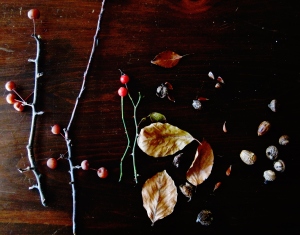Autumn’s the time when the earth shoots and sprouts a bit less and instead does a great deal of dropping, shaking off, and scattering. The fun lies in catching the good stuff before the housekeeping winds of Winter blow it all away.
My usual friendly cautionary note about picking wild edibles goes like this:
1) Be sure that what you’re about to pick and eat is what you think it is. Please don’t wing it. Shoot for old age.
2) Don’t pick anything off your neighbor’s lawn unless a) she owes you one b) she owes you several c) you know she doesn’t use pesticides d) it’s under cover of darkness e) in which case leave my name out of it.
3) Don’t pick anything close to roadsides where they likely have been urologically christened by every domestic pet within five miles, most notably the Alsatian across the street that routinely drinks out of the potholes in the Quik Chek lot.
From left to right:
Crabapples (Malus) I wrote about this little treasure a while back. Wild crabapples are a little grainier in texture than their voluptuous full-sized apple cousins, and for my taste, they need a bit of sugar to be palatable. Making jam from crabapples is a special fall thing for me, even though making it is a bear because they’re so small and their seeds are the size of sesame seeds. Having good music in the background goes a long way. I add a hefty dose of New Jersey honey to the pot, making it 100% local. You can also make crabapple liqueur if you steep them in vodka with granulated sugar.
Rose Hips (Rosa) Another jammy choice, and a vintage one. Folks during World War II ate a lot of rose hip jam because it was full of Vitamin C, which was tough to access then. They’re tart, a little bit astringent like their cousins above (so they need sugar, too) and wildly healthy, full not only of Vitamin C but of antioxidants and lycopene.
Beech Nuts and Leaves (Fagus) As a Laura Ingalls Wilder diehard all my life, I knew beech nuts were edible. She wrote about her husband as a boy, gathering and eating them in upstate New York, describing the spiny little husks and the three-cornered nuts they contained, and saying they were ‘solidly full of nut.’ But the leaves being edible as well? News to me, but cool news. Freshly picked, they can be eaten in salads or even steeped in gin.
Acorns (Quercus) When I took Anthropology in college I learned that American Indians ate acorns. Making them edible takes some doing, and they knew what they were doing; they must be smashed and rinsed with a lot of water to release toxins. I’d love to try them. Has anyone ever prepared acorns for food or eaten them?
Missing from this list: Sassafras. Here I was all ready to dig up one of the 764 and counting plants that grow around my lake and steep the roots to make another American Indian specialty, a primitive form of root beer, when the heavy winds last week blew all of the telltale mitten-shaped leaves off. They’re all out there now, mittenless and mocking, but I’ll hit them up come spring. Stoked to write about it.
http://en.wikipedia.org/wiki/Rose_hip
http://en.wikipedia.org/wiki/Beech
http://en.wikipedia.org/wiki/Oak















